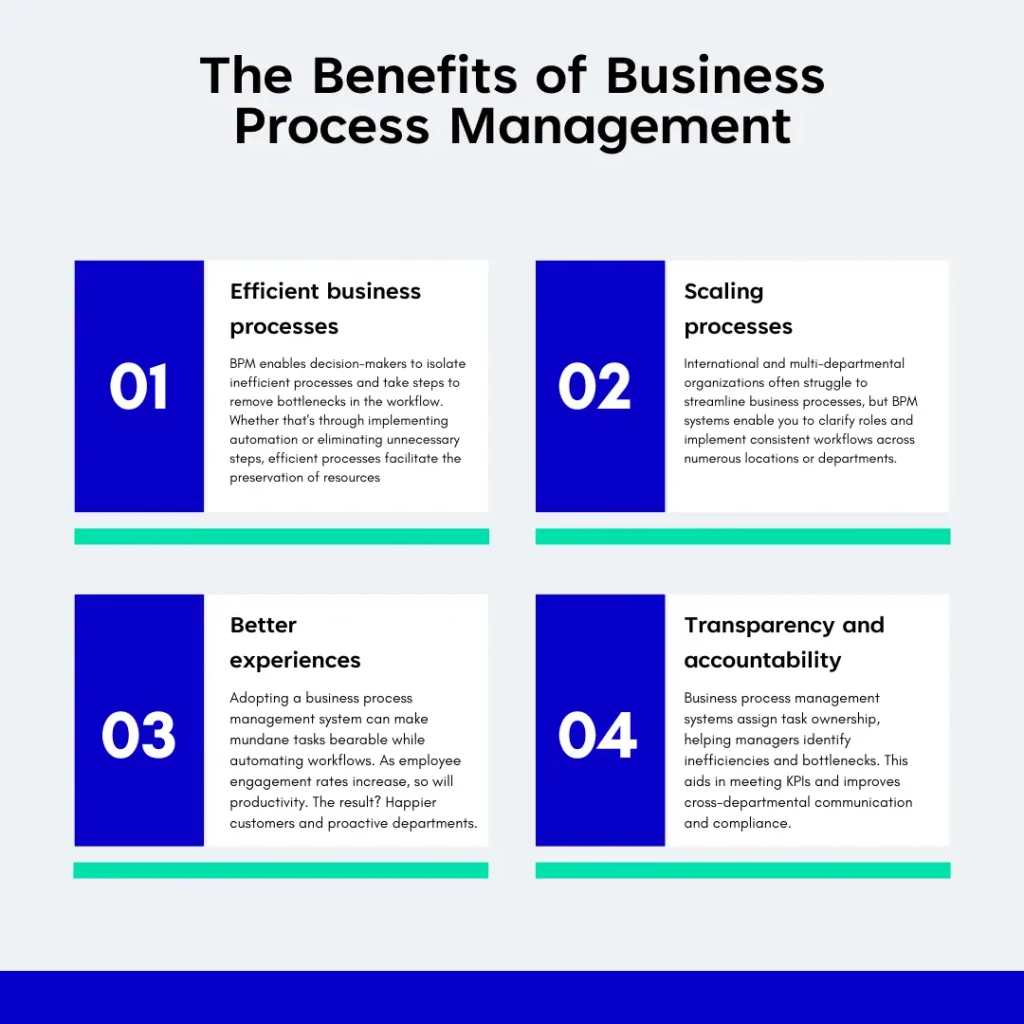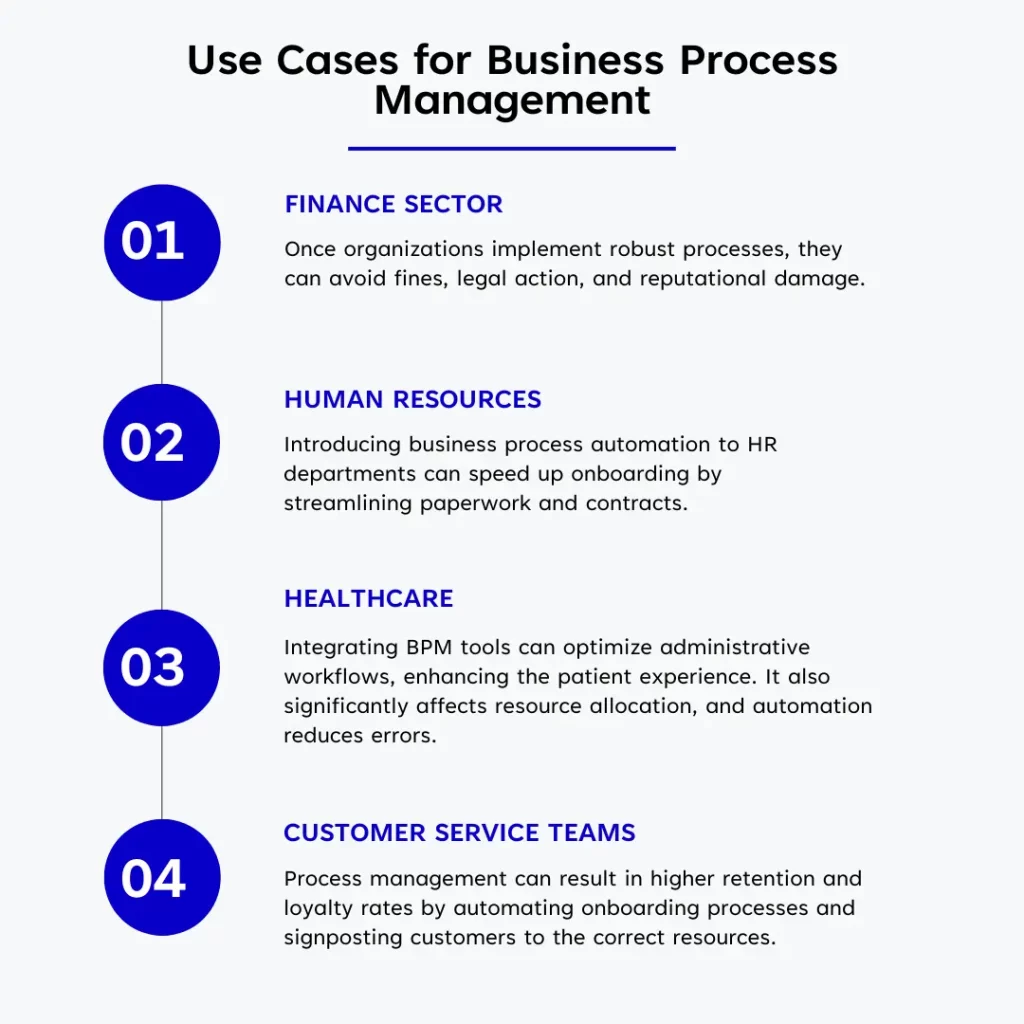Efficiency and adaptability are key to staying competitive in business. This is where Business Process Management (BPM) comes into play. BPM isn’t just a buzzword; it’s a critical framework that allows companies to streamline operations, improve efficiency, and adapt to ever-changing market demands.
Whether you’re a small startup looking to scale or a large corporation aiming to optimize your processes, understanding and implementing BPM can be a game-changer.
Let’s explore what BPM is all about and why it’s essential for your company’s success.
What is business process management (BPM), and why is it important?
While manual business process management is a complex task with plenty of room for error, artificial intelligence paved the way for breakthroughs in BPM software solutions.
BPM uses IT systems to analyze your business processes and identify inefficiencies. Once these inefficiencies are identified, BPM uses modeling to test potential changes and how they align with business objectives.
The scope of business process management depends on an organization’s size and infrastructure. Some companies might use it to refine customer onboarding processes, while others might implement it across departments for a complete organizational transformation.
The types of business process management:
Human-Centric BPM
Human-centric BPM focuses on workflows that require human involvement, assessing areas for improvement and isolating opportunities for automation. Organizations can optimize business processes by implementing intuitive user interfaces and analyzing how employees interact with systems.
Integration-Centric BPM
Integration-centric business process management doesn’t require human involvement. It automates and streamlines processes by integrating data sources, systems, and software, such as customer relationship management (CRM) and HR software.
Document-Centric BPM
Documentation can take up a lot of time in an organization—especially contracts between vendors and clients. This form of business process management aims to streamline the creation and approval workflows when dealing with documentation.
The benefits of business process management
Implementing BPM solutions can help small businesses and international enterprises identify operational inefficiencies and provide a better experience for employees and clients. The availability of BPM software also means anyone can analyze and streamline business operations.
Efficient business processes
BPM enables decision-makers to isolate inefficient processes and take steps to remove bottlenecks in the workflow. Whether that’s through implementing automation or eliminating unnecessary steps, efficient processes facilitate the preservation of resources.
In turn, this leads to cost savings and higher ROIs. Research from Gartner estimates that 80% of organizations using BPM experience internal returns of around 15% (Process Excellence Network).
Scaling processes
International and multi-departmental organizations often struggle to streamline business processes, but BPM systems enable you to clarify roles and implement consistent workflows across numerous locations or departments.
While manual BPM often results in a lack of clarity, software can align with your growth goals and identify key areas for automation.
Better experiences
Repetitive and mundane tasks are significant sources of discontent among employees. According to CV-Library, over 44% of workers feel bored at work, with 26.6% revealing they perform the same daily tasks.
Adopting a business process management system can make mundane tasks bearable while automating workflows. As employee engagement rates increase, so will productivity. The result? Happier customers and proactive departments.
Transparency and accountability
Business process management systems identify owners for specific tasks, allowing managers to isolate who’s responsible for inefficiencies. Not only does this help organizations meet KPIs, but it also exposes bottlenecks in current systems.
Increased transparency and accountability can support cross-departmental communication while monitoring compliance.
The BPM lifecycle
Understanding the business process management lifecycle is integral to identifying which workflows require improvement and tracking your changes‘ impact. There are five BPM lifecycle steps, and each plays a significant role in ensuring your organization achieves positive outcomes:
- Process Design: The first step is to identify and outline each milestone within a process, then split it into individual tasks with owners. This makes it easier to isolate workflow steps and pinpoint improvement areas.
- Modeling: Modelling involves constructing a visual representation of your process, including task outlines, data flows, and timelines. Business process management software is vital in this stage, as it eliminates the room for error and creates comprehensive models.
- Execution: Proof of Concept testing enables organizations to evaluate new processes within a small group, which removes room for error and prevents disruptions. If the new process receives positive feedback, you can implement it across departments or geographic locations.
- Monitor: All processes should be monitored to see how they improve business outcomes. The monitoring stage also enables you to remove further bottlenecks.
- Optimise: Once a process is in place, you can evaluate it to assess whether certain elements need strengthening. When you optimize existing processes, it’s easier to reach your goals and ensure efficiency.
Use cases for BPM
Integrating a business process management tool into your operations is a positive step in prioritizing change and transformation. However, the sheer capability of these solutions often means businesses find applying business process management to specific workflows challenging.
Here are some use cases that clearly highlight the applications for BPM.
Human resources
Introducing business process automation to HR departments can speed up onboarding by streamlining paperwork and contracts. Communication between HR and employees can also improve, as automated business processes can accept vacation applications and monitor personal development.
Finance sector
The finance industry is highly regulated, making compliance monitoring essential across all departments. BPM systems can assess workflow management and identify areas of concern. Once organizations implement robust processes, they can avoid fines, legal action, and reputational damage.
Customer service teams
Today’s customers expect seamless service, making support more important than ever. Process management can result in higher retention and loyalty rates by automating onboarding processes and signposting customers to the correct resources.
Healthcare
The healthcare sector experiences numerous complexities, from data protection to care coordination and medical errors. Integrating BPM tools can optimize administrative workflows, enhancing the patient experience. It also significantly affects resource allocation, and automation reduces errors.
How does BPM fit with IT?
Business process management and IT are powerful combinations. Think of it this way: BPM is the architect, analyzing processes and modeling them to achieve operational efficiency. IT is the construction company that brings the design to life and ensures optimal results.
IT systems play a significant role in each step of BPM, improving agility and outcomes. Here’s how the powerful partnership works.
- Integration: BPM supports integrating IT systems throughout departments, allowing them to share data and enhance accuracy.
- Process Improvement: IT systems collect and analyze data to provide clarity about different processes. This enables decision-makers to identify bottlenecks and refine their business strategy.
- Risk Management: Manual compliance monitoring is a time-consuming process that requires expertise. Integrating BPM software means organizations can receive real-time risk updates and mitigate them before they become significant compliance breaches.
- Customer Experience: IT applications make it easier to manage customer complaints and improve service quality. Gathering insights into processes supports organizational change and evaluates whether your workflows are providing results.
BPM and automation
While BPM and automation are separate technologies, their collaboration can improve accuracy, efficiency, and project management.
Business process management offers a holistic approach. Robotic Process Automation (RPA) uses advanced technology to automate mundane and repetitive tasks. Integrating both enables the refinement of existing and new processes.
Task automation
Using BPM optimization applications enables you to automate manual processes or focus on individual workflow tasks. For example, if a process involves data collection or sending contracts, RPA will preserve resources by automating these tasks.
Efficiency and flexibility
Automating business processes can save time and allow employees to focus on the tasks that require human creativity. For example, RPA functionality within project management software can streamline workflows and enable project managers to focus on strategic initiatives and leadership.
Accuracy
Data collection and even simple administrative tasks leave room for error, but automation can enhance accuracy and monitor for compliance issues. RPA can create audit trails, making it easier for organizations to adhere to regulations.
Analysis
Gathering insights about different processes, from real-time to predictive analytics, is integral to continuous improvement. RPA can collect data on an entire process and tasks within that process, allowing decision-makers to isolate which elements require refining.
Common challenges when implementing BPM
Business process management is a complex task that requires a multi-pronged approach. While it does come with numerous challenges, each is easy to navigate. They include:
- Unclear long-term objectives and immediate goals.
- Unenthusiastic employees due to a lack of clarity regarding BPM applications and fear of job losses.
- A lack of testing protocols and infrastructures.
- Ambiguity about how to identify appropriate tools and measures for each process.
- Poorly documented processes that remain hidden.
- Problems with navigating and dealing with third-party contracts.
Best practices when using business process management tools:
- Make sure your goals are idealistic but achievable. Ambition is vital to innovation and growth, but it’s important to understand the balance between possible and unobtainable.
- BPM should always focus on enhancing performance—whether automating certain processes, refining task management, or enhancing customer experience.
- All stakeholders deserve transparency when implementing BPM software. Let them know what the software’s for and ensure your workforce that it’s not replacing their jobs.
- Focus on core processes that have the most impact on organizational goals first.
- Assess which BPM tools will best integrate with your current IT systems and focus on the long-term benefits each provides. What’s right for one business might not suit your organization’s needs.
- Follow each step of the BPM lifecycle, and don’t rush into the changes. Implementing automation and changing business rules in stages enables you to monitor their impact.
- Test each process model before rolling it out to departments or the entire organization. This allows you to assess whether it will achieve the desired results.
- Document new processes, including how they’re impacting your organization. Being able to justify your changes will inspire employees and let external stakeholders see the positive outcomes of each process improvement.
- Remember that BPM is an ongoing investment that requires regular monitoring and adaptation. It’s not a one-time solution.
Available BPM software solutions
Numerous technologies make BPM more accessible for organizations of all sizes. While some applications are separate, investing in a complete BPM suite enables you to save money and manage end-to-end processes.
Process mining tools
Process mining occurs in the discovery stage, enabling you to discover and analyze your business processes. Many process mining tools also include task mining features to map and monitor individual tasks.
Design tools
Design tools model ideal processes and let you simulate potential outcomes. They’re powerful ways to identify risks and ensure your future processes align with organizational goals.
Optimization tools
Using optimization tools is the final step in transforming your processes. They automate and integrate your systems, allowing for flawless process monitoring.
The future of business process management
Business process management isn’t a new concept, but technological advances mean organizations of all sizes can integrate it into their operations. Generative AI will continue to play a defining role in optimizing and refining workflows and business processes.
In the future, we can expect to see the automation of more complex business processes instead of mundane and repetitive tasks, further optimizing workflows and contributing to decision-making.
Most importantly, BPM software is already accessible to non-technical individuals, but the technology will simplify it further.
As you can see, BPM will continue to play a vital role in efficiency and productivity. Organizations that don’t adopt it could be left behind.
If you’d like to plan for the future and ensure your company thrives in competitive environments, please book a free demo of our extensive BPM suite that offers end-to-end process management.
iGrafx clients also receive a free trial, allowing you to test our software and decide whether it suits your organization.





